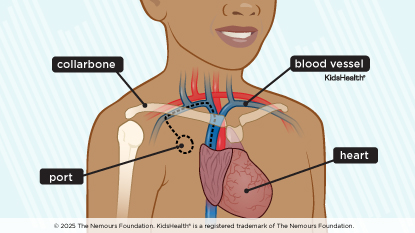A port is a medical device that provides easy access to the bloodstream to give medicines and draw blood. It has a small dome just under the skin that connects to a catheter (a thin, hollow tube). The catheter goes into a large vein (blood vessel) that leads to the heart.
To use the port, a needle is put through the skin into the dome. This is called accessing the port. It is easier and less painful than a typical needlestick.
Your child had a port placed. Once the incision (cut that was made to place the port) heals, your child can do pretty much all the activities they did before they got the port.


Follow your health care provider's instructions for:
Other instructions:

Your child has signs of an infected port, such as:

Your child has a high fever or chills. This can be a sign of a serious infection.
You know your child best. If they have symptoms that worry you, call your health care provider or take them to the ER right away.

What problems can happen from a port? Most people who have a port don't have any problems. But sometimes, it can get infected or stop working. If it gets infected, health care providers start antibiotics right away, since an infection in the blood can be serious. Very rarely, a port can lead to a blood clot.
How long can a port stay in? A port can be removed after a few months or even years.